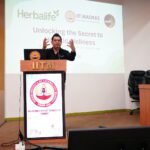World Homoeopathy Day: “Holistic Healthcare remains a very big attraction. Best of the doctors are moving towards homoeopathy. There’s a mood for Holistic Healthcare. There’s a mood to go toward stress free life from a stressful life.” Prime Minister Narendra Modi
- World Homoeopthay Day is observed on April 10 every year.
- Homoeopathy is the world’s second-largest medical system.
India
healthysoch
New Delhi, April 09, 2025:
 Rooted in the principle of “like cures like,” Homoeopathy is a natural way of healing that says that a substance causing symptoms of a disease in a healthy individual would cure similar symptoms in a sick individual. With roots going back over two centuries, Homoeopathy is the world’s 2nd largest system of medicine, trusted by millions for its safe and holistic healing approach.
Rooted in the principle of “like cures like,” Homoeopathy is a natural way of healing that says that a substance causing symptoms of a disease in a healthy individual would cure similar symptoms in a sick individual. With roots going back over two centuries, Homoeopathy is the world’s 2nd largest system of medicine, trusted by millions for its safe and holistic healing approach.
Every year, on April 10, India joins the world in commemorating World Homoeopathy Day, marking the birth anniversary of Dr. Samuel Hahnemann, the father of homoeopathy. In India, this day holds a particular significance, as more than 100 million people in the country depend on this treatment.
Since 2016, the Central Council for Research in Homoeopathy (CCRH) has been celebrating World Homoeopathy Day with a series of impactful events that highlight the role of research in the global growth of homoeopathy. These annual gatherings bring together homoeopathic doctors, scientists, chemists, physicists, microbiologists, and pharmacologists, all united by a shared goal—to showcase the scientific strength and evidence-based potential of this gentle system of healing.
This year, the celebration reaches new heights with India’s largest-ever Homoeopathy Symposium, hosted at the Mahatma Mandir Convention & Exhibition Center in Gandhinagar, Gujarat. The event jointly organised by CCRH, National Commission for Homoeopathy [NCH] and National Institute of Homoeopathy [NIH] will feature insightful discussions, groundbreaking research presentations, and the biggest homoeopathy industry exhibition in the country. It will also offer a vibrant platform for innovation, collaboration, and global recognition of Indian homoeopathy.
Glimpse of Homoeopathy in India:
Homoeopathy has quietly built one of the strongest healthcare support systems in India. Behind its soft approach lies a solid framework of doctors, hospitals, colleges, and research. Over 3.45 lakh registered homoeopathic doctors are working across the country to bring gentle, affordable healing to millions of people.
India is also home to 277 homoeopathy hospitals that offer inpatient care. These hospitals help patients who don’t need emergency treatment but still need careful attention. Alongside, there are 8,593 homoeopathy dispensaries spread across towns and villages, delivering basic health services. For those who need longer monitoring and recovery, India offers 8,697 homoeopathy beds in AYUSH wellness hospitals.
Education in homoeopathy is also thriving. There are 277 colleges across the country. These include 197 undergraduate institutes, 3 standalone postgraduate colleges, and 77 combined UG/PG colleges. All of these come under the National Commission for Homoeopathy, Ministry of Ayush. These institutions are powered by 7,092 dedicated teaching faculty members, shaping the next generation of BHMS (Bachelor of Homoeopathic Medicine & Surgery) doctors.
On the pharmaceutical front, 384 industries are involved in producing homoeopathic medicines in India. This ensures the availability of high-quality, standardised remedies across the country. To support quality, 1,117 official pharmacopoeial monographs for homoeopathic drugs have been published—providing a reliable reference for safe and effective medicine preparation.
With 35 dedicated research centres and OPDs under the Central Council for Research in Homoeopathy (CCRH), India is pushing the boundaries of what this ancient system can do in the modern world.
And to keep everything running smoothly, 28 State Councils and Boards ensure that doctors are well-qualified and ethically registered, maintaining public trust across the healthcare system.
Homoeopathy Legislation in India
Homoeopathy in India has grown on the back of a strong legal and institutional framework that began with the Homoeopathy Central Council Act, 1973. This landmark legislation was designed to regulate homoeopathic education and professional practice across the country. Modelled on the Indian Medical Council Act of 1956, it played a foundational role in institutionalising homoeopathy and ensuring uniform standards across the nation.
However, with time, the system began to face challenges. Gaps in governance, inconsistencies in education quality, and lack of transparency highlighted the need for comprehensive reforms. To address these issues and modernise the regulatory structure, the Ministry of Ayush established the National Commission for Homoeopathy (NCH) through a notification dated 5th July 2021. This move repealed the 1973 Act and brought into force the National Commission for Homoeopathy Act, 2020.
As a statutory body under the Ministry of Ayush, NCH is now responsible for regulating the system in a modern and transparent manner. In line with this vision, the Commission introduced the National Commission for Homoeopathy (Medical Research in Homoeopathy) Regulation, 2023, which lays down clear guidelines for conducting research in the field—ensuring it is scientifically sound, ethical, and evidence-based.
Homoeopathy Infrastructure in India:
India’s homoeopathy sector is regulated by multiple expert bodies working in tandem:
- National Commission for Homoeopathy (NCH) – The National Commission for Homoeopathy (NCH) was established under the National Commission for Homoeopathy Act, 2020, which came into effect on 5th July 2021 through a gazette notification. With this, the Board of Governors and the Central Council of Homoeopathy, constituted under the Homoeopathy Central Council Act, 1973, were dissolved.
- Central Council for Research in Homoeopathy (CCRH) – Central Council for Research in Homoeopathy (CCRH) is an apex research organization under Ministry of Ayush, which undertakes coordinates, develops, disseminates and promotes scientific research in Homoeopathy through its network of 27 Research Institutes/units and 07 Homoeopathic treatment centres and is carrying out intramural research including collaboration with institutes of excellence, promoting Homoeopathy and offering healthcare services through the OPDs/IPDs of the above institutes/units and treatment centres.
- Pharmacopoeia Commission for Indian Medicine & Homoeopathy (PCIM&H) – It is a subordinate office under the Ministry of AYUSH, responsible for developing pharmacopoeias and formularies and serving as the Central Drug Testing cum Appellate Laboratory for Indian systems of Medicine and Homoeopathy. Initially established as PCIM on 18th August 2010 and registered under the Societies Registration Act, 1860, it was renamed PCIM&H on 20th March 2014 following the inclusion of Homoeopathy.
Homoeopathy in India has grown into a robust and trusted system of healthcare, backed by strong infrastructure, legal support, and scientific research. With a large network of practitioners, institutions, hospitals, and research centers, India plays a leading role in promoting and advancing homoeopathy globally. Celebrations like World Homoeopathy Day are a reminder of the country’s commitment to safe, evidence-based, and affordable healing. The coordinated efforts of the NCH, CCRH, and PCIM&H continue to modernize and strengthen homoeopathy, ensuring its relevance in the 21st century.







